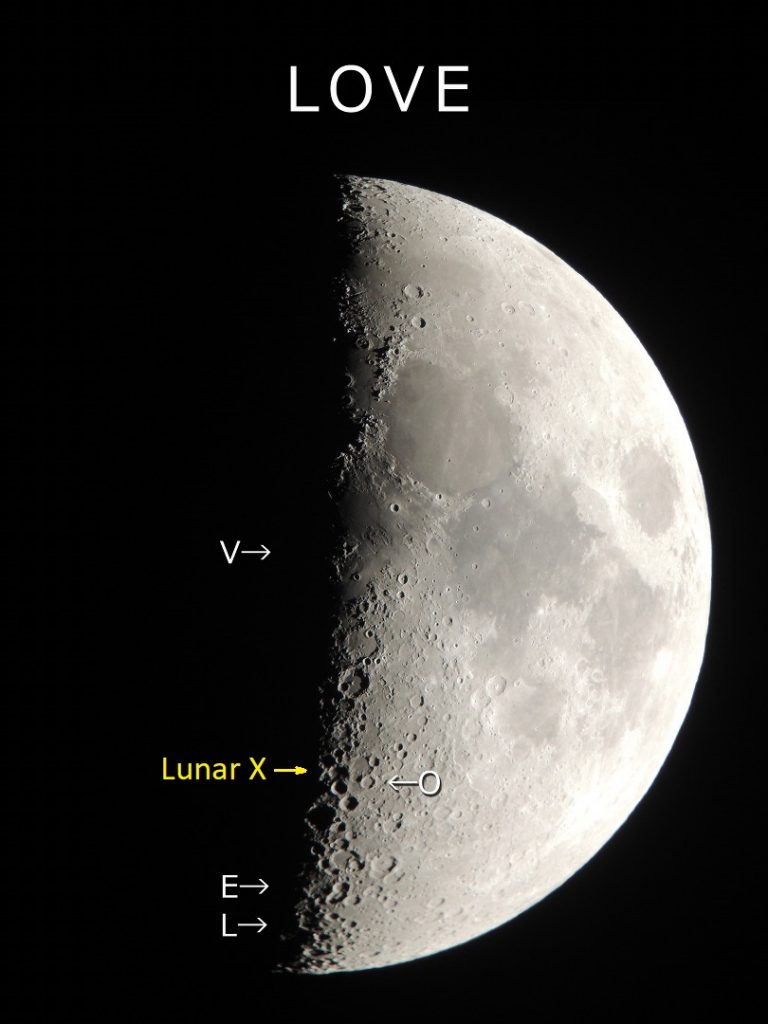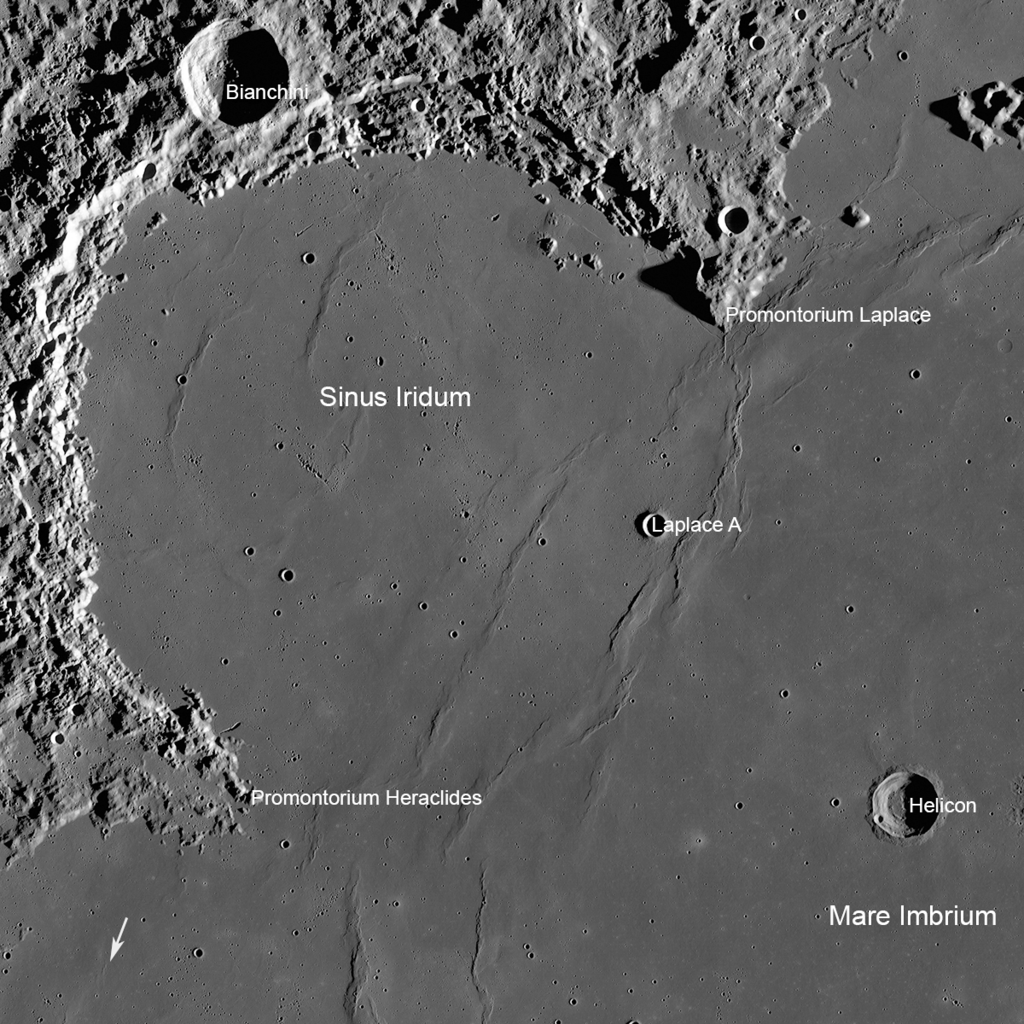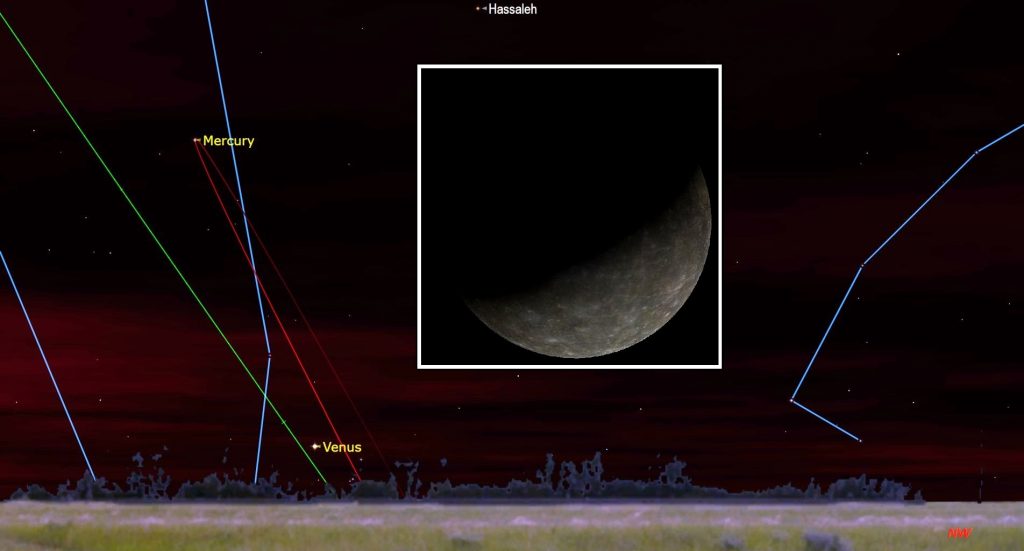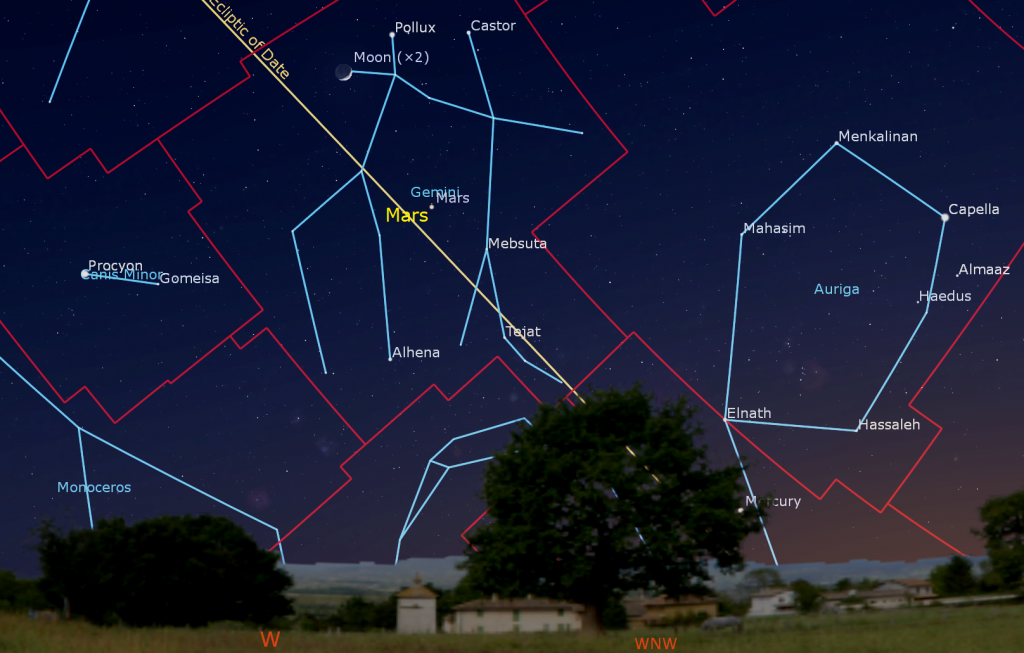Waxing Moon Views Include an X, an Occultation, and a Golden Handle while the Inner Planets Dance at Dusk with Mars!

This fantastic image of the First quarter moon was taken during mid-twilight on April 22, 2018 by Michael Watson of Toronto. The Lunar X, an hour or so past its peak, is visible below centre just to the right of the terminator. Michael’s galleries of images are hosted at https://www.flickr.com/photos/97587627@N06/albums
Hello, Late Spring Stargazers!
Here are your Astronomy Skylights for the week of May 16th, 2021 by Chris Vaughan. Feel free to pass this along to your friends and send me your comments, questions, and suggested topics. You can also follow me on Twitter as @astrogeoguy! Unless otherwise noted, all times are expressed in Eastern Time. To subscribe to these emails please click this MailChimp link.
I can bring my Digital Starlab portable inflatable planetarium to your school or other daytime or evening event, or teach a session online. Contact me through AstroGeo.ca, and we’ll tour the Universe, or the Earth’s interior, together!
The moon, starting this week by occulting a star in Gemini, will remain a pretty sight during evening all week and will feature the Lunar X on Tuesday. Mercury’s recent terrific apparition will peak at greatest elongation tonight – but its dance with brighter Venus will continue all week long. Early risers can enjoy the bright gas giant planets. Read on for your Skylights!
Moon-Doings!
In case you missed my note about it last week, observers in the eastern continental USA and Canada can watch the waxing crescent moon pass across (or occult) a medium-bright star named Kappa Geminorum (or κ Gem) tonight (Sunday)! These lunar occultation events happen because the moon is steadily travelling eastward, following its orbit around Earth. Earthlings see the moon shift by about its own diameter every hour when compared to the stars beyond it. Stars that are positioned within about 5 degrees of the ecliptic are occulted by the moon from time to time – and stars located within a few degrees of the ecliptic can be occulted by the moon and planets. Unless the star is relatively bright, we don’t make much of a fuss about the event.

κ Gem’s point of light will wink out when the dark leading edge of the moon reaches it. (That’s called ingress). The star will re-appear from behind the bright, right-hand (eastern) limb of the moon about an hour later. (That’s called egress). Ingress and egress times vary a lot by your latitude. If, from your vantage point, the star disappears near the moon’s equator, it will be hidden longer because the moon’s disk is widest there. If the star disappears while closer to either of the lunar poles, the occultation will be shorter for you because the moon’s disk is narrower there (measured east to west).
Sometimes a star will just barely skim along the northern or southern pole of the moon in a grazing occultation. Those are fun to see in telescopes because the star can appear and disappear many times as it passes behind and between mountains along the moon’s edge.
You can use Stellarium or another astronomy app to look up the times where you live. In the Greater Toronto area, Kappa Geminorum will disappear at 9:29 pm EDT and then re-appear at 10:34 pm EDT. In the Eastern time zone, the sky will be just getting dark when the show starts. In the Central Time zone, the sky might be too bright when the occultation begins at 8 pm CDT – but your zoomed-in telescope view might still show the star. The Maritimes will have a nice dark sky, but the moon will be lower.
Wherever you are observing this occultation from, start watching a few minutes before the appointed times. The star will be most visible in binoculars and backyard telescopes – but remember that a telescope will likely invert and/or mirror the scene. I posted a diagram of the occultation here.

For the rest of this week, the moon will be perfectly positioned for viewing all over the world. You can look for it in the daytime sky, or wait until the sun has set and enjoy it after-dinner! As the moon increases it angle from the sun each night, it will wax fuller and rise (and set) later. The sunlight reaching the moon along the curved terminator, the boundary between the lit and dark hemispheres, is nearly horizontal – so it casts deep black shadows to the left (lunar west) of every bump, crater rim, and mountain peak. The views under magnification are breathtaking, and new regions get that treatment each night.
On Monday night, the moon will pass only a few finger widths to the upper right (or 3° to the celestial north) of the Beehive Cluster (or Messier 44), a large open star cluster in Cancer (the Crab). These encounters occur frequently because the cluster is located only one degree north of the ecliptic. The moon and the cluster will both fit within the field of view of binoculars, but the bright moon will outshine the clusters’ stars. To see more stars, try hiding the moon just outside your optics’ field of view. From Tuesday to Thursday this week, the moon will cross through the stars of Leo (the Lion).
Several times a year, for a few hours near its first quarter phase, a feature on the moon called the Lunar X becomes visible in powerful, tripod-mounted binoculars and backyard telescopes. Luckily, the X will appear on Tuesday evening, May 18! When the rims of the craters Purbach, la Caille, and Blanchinus are illuminated from a particular angle by the sun, they form a small, but very obvious X-shape. The phenomenon is an example of pareidolia – the tendency of the human mind to see familiar objects when looking at random patterns. The Lunar X is located near the terminator, about one third of the way up from the southern pole of the moon (at lunar coordinates 2° East, 24° South). A prominent round crater named Werner sits to its lower right (or lunar southeast).

When the sun’s light first touches those craters the X will be indistinct. The shape will intensify to peak visibility at around 9 pm EDT on Tuesday, and then fade when the surrounding terrain becomes illuminated an hour or two later. The peak will occur during waning daylight for observers in the eastern Americas – but you can observe the moon in a telescope during daytime, as long as you take care to avoid the sun. The pattern will be visible anywhere on Earth where the moon is shining, especially in a dark sky, between 23:00 on May 18 and 03:00 UT on May 19.
During a Lunar X event, you can also look for the Lunar V and the Lunar L. The “V” is produced by combining the small crater named Ukert with some ridges to the east and west of it. It is located a short distance above the moon’s equator at lunar coordinates 1.5° East, 8° North. For a further challenge, see if you can see the letter “L” down near the moon’s southern pole. Its position is to the southwest of three prominent and adjoining craters named Licetus, Cuvier, and Heraclitus, which resemble Mickey Mouse’s head and ears.
The moon will officially complete the first quarter of its orbit around Earth, counting from the last New Moon, at 3:12 pm EDT (or 19:12 GMT) on Wednesday. At that time, the relative positions of the Earth, sun, and moon will cause everyone on Earth to see it half-illuminated – on its eastern side. The terminator will temporarily become a straight line.

During the coming weekend, the now gibbous moon (i.e., more than 50%-illuminated) will traverse the lengthy constellation of Virgo (the Maiden). Friday and Saturday night will both offer good views of the Golden Handle effect. On those nights, the terminator will fall to the left (or lunar west) of Sinus Iridum, the Bay of Rainbows. The circular, 249-km-diameter feature is a large impact crater that was partly flooded by the same basalts that filled the much larger Mare Imbrium to its right (lunar east). The “Golden Handle” is produced when slanted sunlight brightens the eastern (right-hand) side of the prominent, curved Montes Jura, the mountain range (yes – the old crater rim) that surrounds the bay on the top and left (north and west). The mountains extend into Mare Imbrium as a pair of protruding promontories named Heraclides and Laplace at the bottom and top, respectively. You can see the feature with sharp eyes – and easily in binoculars and backyard telescopes. Sinus Iridum is almost craterless, but hosts a set of northeast-oriented dorsae or “wrinkle ridges” that are revealed under magnification at this phase.
The Planets
As I have been saying, May has been Mercury Month for Northern Hemisphere observers! The planet’s position on the high (northerly) side of a steep evening ecliptic plane has been giving us our best opportunity of the year to see the speedy planet after sunset. (Observers in the Southern Hemisphere aren’t so lucky, however.)

The Mercury show will peak tonight (Sunday) because the speedy planet will reach its widest angular separation of 22 degrees east of the Sun, and peak visibility. Astronomers call this phenomenon a planet’s Greatest Eastern Elongation. From tomorrow on, the planet will be descending toward the sun.
Mercury is sharing the sky with much brighter Venus. Those planets’ motions around the sun at different rates has produced a “Dance of the Inner Planets”. Starting at about 9:15 pm local time tonight (Sunday), Mercury should become visible as a medium-bright dot sitting about a fist’s diameter above the west-northwestern horizon. Venus will be located less than a fist’s diameter below Mercury (and a little bit to the right). You’ll need a horizon that is free of both clouds and obstructions. Venus will set by about 9:45 pm and Mercury will follow it down almost an hour later.

On each subsequent clear evening this week, Mercury will drop lower and Venus will climb a little higher. Next Sunday night, Mercury will be less than a palm’s width to Venus’ upper left (or celestial east). Both planets will remain easily seen for most of this week, especially between about 9:30 and 10 pm local time.
If you wait until the sun has completely disappeared below the horizon you can use your telescope on Mercury and Venus. Venus, on far side of the sun from Earth, will show a round, nearly fully illuminated disk. Mercury, which is about the same distance away from us as the sun, will look somewhat less than half-illuminated – on the sunward side, of course! Telescope views when the planets are so low in the sky will not be ideal, but their shapes should be apparent!
When the sky has darkened after 9:30 pm local time, look a third of the way up the western sky for the reddish dot of Mars. To help you find it – the very bright yellowish star Capella will be positioned three fist diameters to Mars’ right (or 30° to the celestial northwest). Keeping the same height in the sky, look for the very bright white star Procyon shining off to your left. Mars will be parked just above a line drawn between them – but somewhat closer to Procyon. Castor and Pollux, the twin bright stars of Gemini will be shining above Mars, too – and the Red Planet is making its way towards a rendezvous with those stars in early June! Despite Mars being much farther from Earth now, your telescope will still show that it has a small, ruddy disk. Start looking at Mars as soon as it pops into view. It will be getting too low for telescope views by late evening, and it will set in the west close to midnight local time.

Saturn and Jupiter are continuing to shine in the southeastern pre-dawn sky. Those two planets will start to become visible in late evening towards the end of June! This week yellow-tinted Saturn will rise within the stars of central Capricornus (the Sea-Goat) at about 1:30 am local time, and should be easily visible until almost 5 am.
On Sunday, May 23, Saturn will cease its regular eastward motion through the distant stars of Capricornus and begin a retrograde loop that will last until mid-October. The apparent reversal in Saturn’s motion is an effect of parallax produced when Earth, on a faster orbit, passes the Ringed Planet on the “inside track”. You can observe the planet’s direction change by noting how Saturn’s distance from the nearby bright star Theta Capricornus varies over several days.
Even a small telescope will show Saturn’s rings and several of its brighter moons – especially its largest moon, Titan! Because Saturn’s axis of rotation is tipped about 27° from vertical (a bit more than Earth’s axis), we can see the top surface of its rings, and its moons can arrange themselves above, below, or to either side of the planet. During this week, Titan will migrate counter-clockwise around Saturn, moving from the left (celestial east) of Saturn on Monday morning to below (south) the planet next Sunday. (Remember that your telescope will flip the view around.) As Saturn moves higher in the sky, it will present a more pleasing view as the weeks tick by.

Much brighter and whiter Jupiter is positioned among the stars of western Aquarius (the Water-Bearer) about 1.7 fist diameters to Saturn’s lower left (or 17° to the celestial east). The separation between the two planets will increase slightly every morning. This week Jupiter will rise at about 2:20 am local time and will be easy to see until almost sunrise, which will be happening at about 5:45 am local time.
Due to the very shallow angle of the morning ecliptic in springtime, Jupiter doesn’t get very high above the horizon before the dawn sky swallows it up, especially for viewers in mid-Northern latitudes. That makes it hard to obtain sharp views of the planet in a telescope. Since the ecliptic is more vertical for observers at southerly latitudes, both planets will be higher and clearer in telescopes there. If you are willing to get up early and take your backyard telescope outside, the Great Red Spot (or GRS) will be visible crossing Jupiter on Monday, Wednesday, and Saturday morning.
Public Astro-Themed Events
Every Monday evening, York University’s Allan I. Carswell Observatory runs an online star party – broadcasting views from four telescopes/cameras, answering viewer questions, and taking requests! Details are here. Their in-person Wednesday night viewing has been converted to online via the observatory YouTube channel, where they offer free online viewing through their rooftop telescopes, including their 1-metre telescope! Details are here.
On Wednesday evening, May 19 at 7:30 pm EDT, the RASC Toronto Centre will live stream their monthly Speakers Night meeting. This month will feature Dr. Claire David, Assistant Professor, Physics and Astronomy, York University and Associate Scientist at Fermilab. Her talk is titled What is DUNE? Embark on the underground telescope to pierce the secrets of matter! Everyone is invited to watch the presentation live on the RASC Toronto Centre YouTube channel. Details are here. The RASC Toronto Centre has an archive of their past meetings and guest lectures on their YouTube Channel here.
Our in-person David Dunlap Observatory Saturday night events may be suspended at the moment, but we’re still pleased to offer online programs! On Friday, May 21 from 9 to 10:30 pm EDT, join us for DDO Up in the Sky – featuring live and pre-recorded views of the night sky’s best objects captured through the telescopes of RASC Toronto Centre members. They’ll provide commentary, too. More information and the registration link can be found here. A modest fee goes to support our ongoing efforts to deliver public programs at DDO.
On Thursday, May 20 at 12 pm EDT, RASC National will continue their weekly, half-hour moon-observing series the Moon at Noon featuring Jenna Hinds and guests. Details are here and the registration link is here! Sessions are also livestreamed to YouTube here and can be watched at any time.
On Thursday evening, May 20 at 7 pm, Space Place Canada will stream a free public panel discussion titled Down to Earth: Benefits of Canadian Space Technology. Experts will explore how made-in-Canada space technology enables research, grows our economy, and benefits society down here on Earth. Details and the registration link are here.
My free, family-friendly Insider’s Guide to the Galaxy webcasts with Jenna Hinds of RASC National will return on Tuesday afternoon, May 25 at 3:30 pm EDT. We’re going to talk about safely viewing the sun and the upcoming partial solar eclipse. You can find more details, and the schedule of future sessions, here and here.
Our public sessions at the David Dunlap Observatory may not be running at the moment, but we are pleased to offer some virtual experiences instead in partnership with Richmond Hill. On Sunday afternoon, May 30 from 1 to 2 pm EDT, join me for Ask the Astronomer. We’ll talk about what’s up in the sky lately and answer your space-related questions! Depending on the weather, you may even be able to see views of the sun through a solar scope! Deadline to register for this program is Friday, May 28, 2020 at 3 pm. Prior to the start of the program Richmond Hill will email you information on the virtual program links and any specific information relating to your program. The registration link is here.
Keep looking up, and enjoy the sky when you do. I love questions and requests. Send me some!